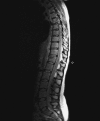Spine fractures caused by horse riding
- PMID: 16408237
- PMCID: PMC3489311
- DOI: 10.1007/s00586-005-1012-5
Spine fractures caused by horse riding
Abstract
Study design: Retrospective study and review of literature.
Objectives: Study of demographic data concerning spinal fractures caused by horse riding, classification of fractures according to the AO and Load Sharing classifications, evaluation of mid-term radiological results and long-term functional results.
Methods: A review of medical reports and radiological examinations of patients presented to our hospital with horse riding-related spine fractures over a 13-year period; long-term functional follow-up is performed using the Roland Morris Disability Questionnaire (RMDQ-24).
Results: Thirty-six spine fractures were found in 32 patients. Male to female ratio is 1:7. Average age is 33.7 years (8-58 years). The majority of the fractures (78%) are seen at the thoracolumbar junction Th11-L2. All but two patients have AO type A fractures. The average Load Sharing Classification score is 4.9 (range 3-9). Neurological examinations show ASIA/Frankel E status for all patients. Surgical treatment is performed on ten patients. Mean follow-up for radiological data is 15 months (range 3-63). Functional follow-up times range from 1 to 13 years with an average follow-up of 7.3 years. Mean RMDQ-24 score for all patients is 5.5 (range: 0-19), with significantly different scores for the non-operative and surgical group: 4.6 vs 8.1. Twenty-two percent of the patients have permanent occupational disabilities and there is a significant correlation between occupational disability and RMDQ-24 scores.
Conclusions: Not only are short-term effects of spine fractures caused by horse riding substantial but these injuries can also lead to long-term disabilities.
Figures




References
-
- Nijland N, Hertog PC den, Ommeren P van (1997) How safe is riding? A study in horse riding injuries (Hoe veilig is ruitersport. Een studie naar omvang, ernst en aard van ongevallen met paarden.). Amsterdam [Netherlands Consumer Safety Institute] Stichting Consument en Veiligheid
-
- Buckley SM, Chalmers DJ, Langley JD. Injuries due to falls from horses. Aust J Public Health. 1993;17:269–271. - PubMed
-
- Danielsson LG, Westlin NE. Riding accidents. Acta Orthop Scand. 1973;44:597–603. - PubMed
-
- Zachariae L. [Dog bites and other lesions caused by animals] Ugeskr Laeger. 1973;135:2817–2819. - PubMed
Publication types
MeSH terms
LinkOut - more resources
Full Text Sources
Medical

